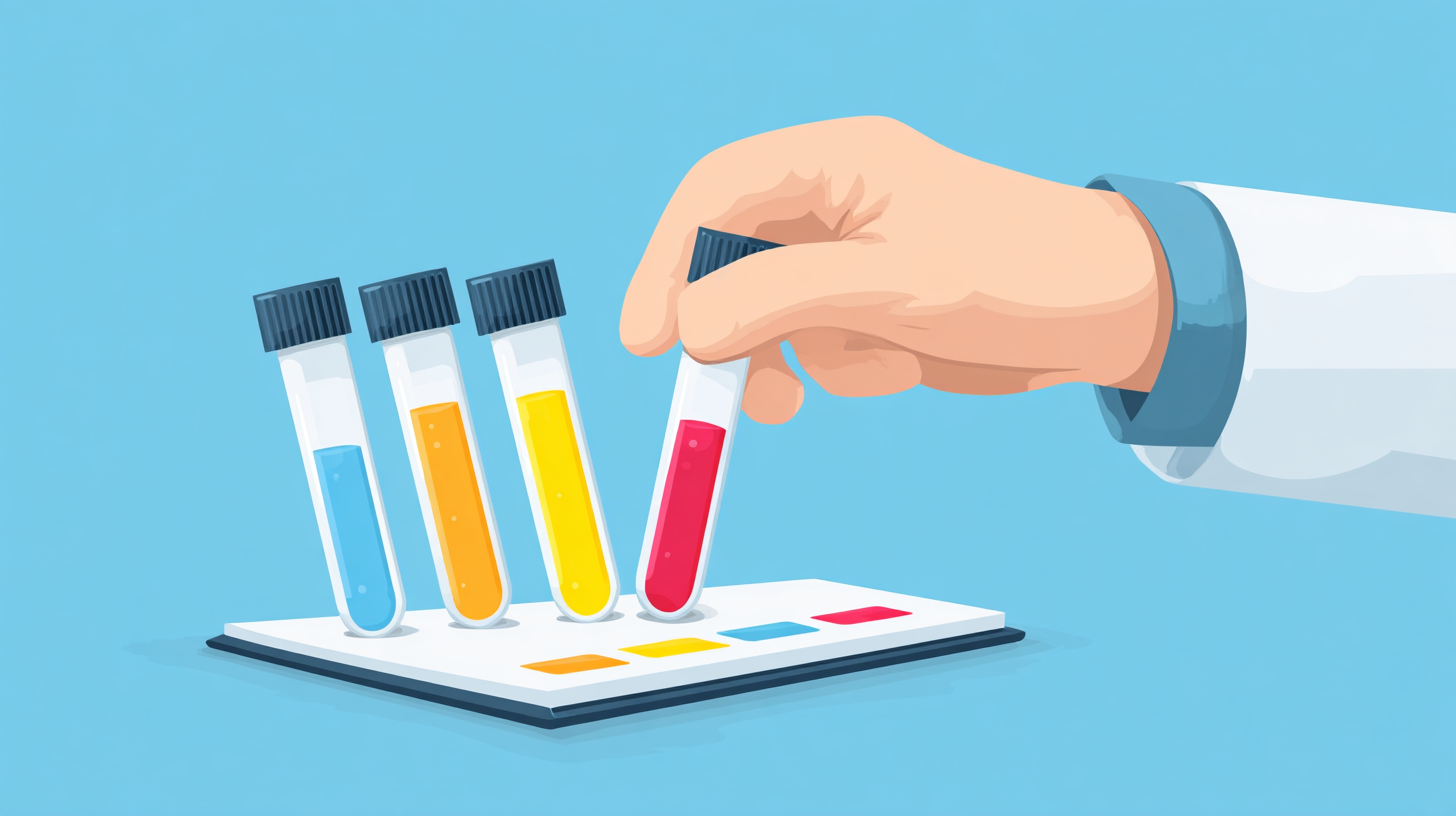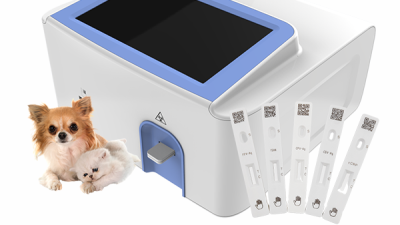Ultimate Guide to Understanding Point Of Care Testing and Its Impact on Healthcare
Table of Contents
- Understanding the Fundamentals of Point of Care Testing in Healthcare Settings
- Key Benefits of Point of Care Testing: Improving Patient Outcomes and Efficiency
- Analyzing Market Trends: Growth and Adoption Rates of Point of Care Testing Devices
- Regulatory Framework: Ensuring Quality and Compliance in Point of Care Testing
- Impact on Chronic Disease Management: How Point of Care Testing Transforms Care Models
- Future Innovations in Point of Care Testing: Emerging Technologies and Their Potential Applications
- Exploring the Impact of Advanced Veterinary Immunofluorescence Analyzers on Diagnostic Accuracy: Insights from Recent Industry Reports
- FAQS
- Conclusion
- Related Posts
In today’s fast-changing world of healthcare, Point Of Care Testing—commonly known as POCT—has really become a game-changer. It’s all about making things more convenient and efficient for both clinicians and patients. Imagine getting test results right away—no waiting around, which means doctors can make quick decisions and, ultimately, improve patient care. At Zhejiang Pushkang Biotechnology Co., Ltd., we truly understand how impactful POCT can be in transforming healthcare delivery. We started back in 2014, and since then, PUSHKANG has grown into a high-tech company dedicated to R&D, manufacturing, and promoting IVD products, especially our expertise in centrifugal microfluidics. Our cutting-edge POCT solutions cover areas like coagulation, biochemistry, CLIA, and molecular testing—placing us at the forefront of diagnostic tech. In this guide, I’ll walk you through some of the key benefits of Point Of Care Testing and share how these innovations are helping shape a more responsive, efficient healthcare system that really puts patients first.

Understanding the Fundamentals of Point of Care Testing in Healthcare Settings
Point of Care Testing, or POCT, is really changing the game when it comes to healthcare diagnostics. It’s all about getting quick results right there on the spot, so doctors and nurses can make decisions faster. Instead of sending samples off to labs far away, these tests can be done right near the patient—sometimes even bedside. That means faster, more accurate diagnoses, which honestly just ups the quality of care we get.
One of the coolest things about POCT is how directly it can affect patient outcomes. Just think about emergency situations—being able to quickly test for things like infections or heart issues can make a huge difference. It helps get patients treated sooner, which can mean fewer complications and shorter hospital stays. Plus, it’s pretty great for patients, too. Getting immediate feedback means people feel more involved in their care—they're not just passively waiting for results but actually participate in their health decisions. All in all, adding tech like this not only makes workflows smoother but also creates a more patient-focused, efficient healthcare environment. Honestly, it’s a pretty big leap forward in how we deliver medical care today.
Impact of Point Of Care Testing (POCT) on Healthcare
This chart illustrates the impact of Point Of Care Testing (POCT) on healthcare, highlighting key benefits such as reduced turnaround time, increased patient satisfaction, and overall improvement in clinical outcomes. Each benefit is rated on a scale of 1 to 10, showcasing the significant advantages POCT offers in healthcare settings.
Key Benefits of Point of Care Testing: Improving Patient Outcomes and Efficiency
Point of Care Testing, or POCT, has really changed the game in healthcare. It allows doctors and medical staff to get quick diagnostic results right where the patient is—no more waiting around for labs to finish. This means care can be more immediate, which often helps improve outcomes because decisions and treatment plans can be made on the spot. Thanks to advances in tech, healthcare providers can assess what's going on with a patient much faster, and that quick turnaround can be a total lifesaver, especially in critical situations. Honestly, it just makes the whole experience better for patients, who appreciate the faster, more personalized care.
At Zhejiang Pushkang Biotechnology Co., Ltd., we’re pretty passionate about using POCT to raise the bar in healthcare. Founded back in 2014, we’ve poured a lot of effort into research and development in the world of in vitro diagnostics. That’s how we’ve managed to develop some pretty innovative POCT products, especially with cutting-edge centrifugal microfluidics technology. Our range covers everything from coagulation, biochemistry, CLIA, to molecular testing. By making the testing process quicker and easier, we’re not just helping hospitals and clinics run more smoothly—we’re really making a difference in patient care too.
Analyzing Market Trends: Growth and Adoption Rates of Point of Care Testing Devices
The global market for Point of Care (POC) testing is really booming these days, especially when it comes to HBA1C testing, which is expected to hit around $550.5 million by 2025. It’s pretty exciting to see how quickly this area is growing — it clearly shows that more healthcare providers are turning to POC devices to get things done faster. Looking ahead, the market might even jump to about $1,080.8 million by 2033, with a solid annual growth rate of around 8.8%. The rise in diabetes cases and the need for quick, reliable diagnostics are definitely major drivers here. Healthcare systems are really pushing for better patient outcomes, and accessible testing plays a big role in that.

But it’s not just about diabetes stuff — the whole healthcare world seems to be moving towards more decentralized testing, you know? Thanks to tech advancements, clinicians are using POC testing more and more to speed up decision-making and improve patient care. Quick results mean better health management, and they also help lighten the load on traditional labs. As the demand for fast, efficient healthcare solutions grows, it looks like POC testing is going to become an even bigger part of how we do healthcare today.
Regulatory Framework: Ensuring Quality and Compliance in Point of Care Testing
When it comes to Point of Care Testing (or POCT), the rules and regulations surrounding it are actually pretty important — they’re key to making sure that tests done outside traditional labs are accurate and up to standard. The FDA gets that POCT plays a pretty big role in providing quicker healthcare, but they also stress the need for strict rules to keep everything running smoothly. According to a report from the NIH, roughly 70% of clinical decisions hinge on lab results, which just goes to show how crucial accurate POCT is for patient care and making sure everything stays reliable.
If you're working in healthcare, keeping up with all the regulations can feel a bit overwhelming. It’s really important to stay in the loop with guidelines from agencies like CLIA, which set the standards your POCT devices need to meet to give trustworthy results. The WHO also has some good advice — emphasizing the importance of quality checks, regular equipment maintenance, and proper staff training to ensure testing stays accurate and dependable.
**Tips:**
- Double-check that all the POCT devices in your facility are CLIA-certified and get calibrated regularly — it’s a must.
- Keep your team sharp by setting up ongoing training to keep everyone up-to-date on best practices and new tech.
- Invest in good data management systems that help track test results and support quality control. It can really save you a lot of headaches down the line.
Impact on Chronic Disease Management: How Point of Care Testing Transforms Care Models
Point of care testing, or POCT, is really changing the way healthcare providers handle chronic diseases. In the past, folks with issues like diabetes or high blood pressure often had to go into clinics just to get labs done, which could mean waiting days or even weeks for results and adjustments. Now, with POCT, testing can happen right there with the patient—giving instant results when it matters most. That immediate feedback helps doctors and nurses make quicker decisions on treatments, which can genuinely improve patient health outcomes.
And honestly, the convenience of POCT can make a huge difference when it comes to keeping patients engaged and sticking to their care plans. When people can see their results right there in the exam room, they're more likely to follow through with tests and treatments. It’s a win-win because it not only makes the whole process smoother but also encourages patients to be more active participants in managing their health. Overall, bringing point of care testing into chronic disease care is a total game-changer—making healthcare more responsive, more personal, and way more patient-friendly.
Future Innovations in Point of Care Testing: Emerging Technologies and Their Potential Applications
The future of point-of-care testing (POCT) is really taking shape thanks to a wave of new tech that's set to shake up healthcare as we know it. Things like lab-on-a-chip devices and testing tools that work right from your smartphone are making things a lot more accessible and faster—it's pretty exciting! If you look at the latest market reports, they're saying the global POCT market might hit around $50 billion by 2027. That just shows how much people want quick, reliable diagnostics in hospitals, clinics, and even at home.

One of the coolest aspects of all this is the rise of CRISPR-based diagnostics. This tech can detect diseases with crazy sensitivity, and best of all, it can be used right at the point of care. That means faster results and also opens doors for more personalized treatment plans that suit individual patients’ needs. Plus, there have been some amazing strides with nano-enhanced biosensors, making tests even more precise and trustworthy. These tools aren’t just shaking up healthcare—we’re also seeing them help safeguard our environment and keep food safe. As all these advancements keep progressing, they’ll probably totally change how we care for patients and lead to way better health outcomes overall.
Exploring the Impact of Advanced Veterinary Immunofluorescence Analyzers on Diagnostic Accuracy: Insights from Recent Industry Reports
The introduction of advanced veterinary immunofluorescence analyzers has marked a significant milestone in enhancing diagnostic accuracy within veterinary medicine. Recent industry reports indicate that utilizing these state-of-the-art instruments can reduce diagnostic errors by up to 30%, thereby improving treatment outcomes for animals. The implications for veterinary practices are profound, as accurate and swift diagnostics can lead to timely interventions, ultimately saving lives and resources.
One of the standout features of these devices is their user-friendly design, allowing for plug-and-play operation that requires minimal training. This is crucial in busy clinical environments where time is of the essence. The portable and compact configurations of these analyzers allow them to fit seamlessly into various healthcare settings, whether in central laboratories or emergency veterinary clinics. Notably, results can be generated in as fast as three minutes, drastically minimizing the waiting period for pet owners and enhancing the overall efficiency of veterinary care.
Furthermore, the stability of reagents at room temperature contributes to the practicality of these devices; many reagents maintain their efficacy and performance over extended periods. This feature not only reduces concerns about expiration, but also minimizes waste, thereby lowering operational costs for veterinary facilities. According to a report by the Veterinary Diagnostics Association, facilities that adopted immunofluorescence analyzers have reported a 25% increase in laboratory throughput, showcasing the effectiveness of these innovations in transforming diagnostic practices.
FAQS
: Point of Care Testing (POCT) is a medical diagnostic process that allows rapid testing and results to be delivered directly at the site of patient care, improving timely decision-making and treatment planning.
POCT improves patient outcomes by providing immediate diagnostic results, enabling healthcare providers to make timely treatment decisions, enhancing patient engagement, and leading to better overall healthcare experiences.
The regulatory framework ensures the quality and compliance of POCT procedures, with organizations like the FDA and NIH setting guidelines to maintain the integrity and accuracy of test results.
Approximately 70% of clinical decisions rely on laboratory results, making accurate POCT essential to ensure effective patient care and timely treatment modifications.
Healthcare providers should ensure their POCT devices are CLIA-certified, regularly calibrated, and that staff are continuously trained on best practices and new technologies.
POCT transforms chronic disease management by allowing immediate test results during patient visits, enabling quick treatment adjustments and enhancing patient adherence to care protocols.
POCT promotes patient engagement by allowing patients to receive real-time test results, encouraging them to take an active role in their health management and follow through with care recommendations.
Zhejiang Pushkang Biotechnology utilizes advanced centrifugal microfluidics technology to develop innovative POCT products across areas such as coagulation, biochemistry, CLIA, and molecular tests.
Best practices include regular maintenance of equipment, continuous staff training, and using data management systems to track POCT results and maintain quality control.
Conclusion
Point of Care Testing, or POCT, has really changed the game in healthcare. It basically brings diagnostic tools right to where patients are, making everything quicker and more efficient. If you’re new to it, understanding how it works is pretty important because POCT lets healthcare providers make fast decisions in a bunch of different settings. The biggest perks? Better patient outcomes and smoother workflows—especially when it comes to managing chronic illnesses where catching things early or acting fast can make a huge difference.
As more and more POCT devices hit the market, it’s good to stay in the loop about current trends and what rules and regulations are out there. Companies like Zhejiang Pushkang Biotechnology Co., Ltd. are leading the charge, using clever tech like centrifugal microfluidics to create cutting-edge POCT products. These are used for all sorts of tests, from blood clotting to molecular diagnostics. Looking ahead, new tech is popping up all the time, promising to make POCT devices even more powerful and essential in today’s healthcare landscape.



